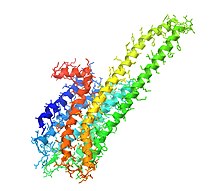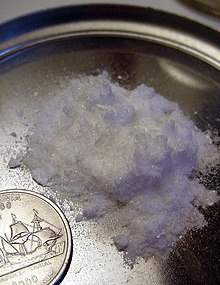Psychedelic drug
[4] Classic psychedelics generally cause specific psychological, visual, and auditory changes, and oftentimes a substantially altered state of consciousness.[2][9][10][11][4] When compounds bind to serotonin 5-HT2A receptors,[12] they modulate the activity of key circuits in the brain involved with sensory perception and cognition.[14][3][5] Many psychedelic drugs are illegal to possess without lawful authorisation, exemption or license worldwide under the UN conventions, with occasional exceptions for religious use or research contexts.[30] Recently, the term entheogen (meaning "that which produces the divine within") has come into use to denote the use of psychedelic drugs, as well as various other types of psychoactive substances, in a religious, spiritual, and mystical context.Most recently, there has been a movement in nonscientific circles to recognize the ability of these substances to provoke mystical experiences and evoke feelings of spiritual significance."[32] While the term psychedelic is most commonly used to refer only to serotonergic hallucinogens,[11][10][33][34] it is sometimes used for a much broader range of drugs, including empathogen–entactogens, dissociatives, and atypical hallucinogens/psychoactives such as Amanita muscaria, Cannabis sativa, Nymphaea nouchali and Salvia divinorum.A number of frequently mentioned or traditional psychedelics such as Ayahuasca (which contains DMT), San Pedro, Peyote, and Peruvian torch (which all contain mescaline), Psilocybe mushrooms (which contain psilocin/psilocybin) and Tabernanthe iboga (which contains the unique psychedelic ibogaine) all have a long and extensive history of spiritual, shamanic and traditional usage by indigenous peoples in various world regions, particularly in Latin America, but also Gabon, Africa in the case of iboga.[63][64][65] After ingesting the drug, the patient normally wears eyeshades and listens to music to facilitate focus on the psychedelic experience, with the therapeutic team interrupting only to provide reassurance if adverse effects such as anxiety or disorientation arise.[69] A June 2024 report by the RAND Corporation suggests psilocybin mushrooms may be the most prevalent psychedelic drug among adults in the United States.[79][80] Psychedelics, such as the tryptamines psilocin, DMT, and 5-MeO-DMT, the phenethylamines mescaline, DOM, and 2C-B, and ergolines and lysergamides like LSD, all act as agonists of the serotonin 5-HT2A receptors.[79] In addition, the intensity of hallucinogenic effects in humans is directly correlated with the level of serotonin 5-HT2A receptor occupancy as measured with positron emission tomography (PET) imaging.[83] In animals, potency for stimulus generalization to the psychedelic DOM in drug discrimination tests is strongly correlated with serotonin 5-HT2A receptor affinity.[79] In accordance with the preceding animal and human findings, it has been said that the evidence that the serotonin 5-HT2A receptor mediates the hallucinogenic effects of serotonergic psychedelics is overwhelming.[79][97] Serotonergic psychedelics have been found to produce frontal cortex hyperactivity in humans in PET and single-photon emission computed tomography (SPECT) imaging studies.[105] Although serotonin itself is non-hallucinogenic, at very high concentrations achieved pharmacologically (e.g., injected into the brain or with massive doses of 5-HTP) it can produce psychedelic-like effects in animals by being metabolized by indolethylamine N-methyltransferase (INMT) into more lipophilic N-methylated tryptamines like N-methylserotonin and bufotenin (N,N-dimethylserotonin).[143] Although several attempts have been made, starting in the 19th and 20th centuries, to define common phenomenological structures of the effects produced by classic psychedelics, a universally accepted taxonomy does not yet exist.[147][148] At lower doses, features of psychedelic experiences include sensory alterations, such as the warping of surfaces, shape suggestibility, pareidolia and color variations.Higher doses often cause intense and fundamental alterations of sensory (notably visual) perception, such as synesthesia or the experience of additional spatial or temporal dimensions.[149] Tryptamines are well documented to cause classic psychedelic states, such as increased empathy, visual distortions (drifting, morphing, breathing, melting of various surfaces and objects), auditory hallucinations, ego dissolution or ego death with high enough dose, mystical, transpersonal and spiritual experiences, autonomous "entity" encounters, time distortion, closed eye hallucinations and complete detachment from reality with a high enough dose."[151] Czech psychiatrist Stanislav Grof studied the effects of psychedelics like LSD early in his career and said of the experience, that it commonly includes "complex revelatory insights into the nature of existence… typically accompanied by a sense of certainty that this knowledge is ultimately more relevant and 'real' than the perceptions and beliefs we share in everyday life.[154][155] In 1898, the English writer and intellectual Havelock Ellis reported a heightened perceptual sensitivity to "the more delicate phenomena of light and shade and color" for a prolonged period of time after his exposure to mescaline.[157][158] Negative experiences, colloquially known as "bad trips," evoke an array of dark emotions, such as irrational fear, anxiety, panic, paranoia, dread, distrustfulness, hopelessness, and even suicidal ideation.However, he called for an "abundance of caution" because in the absence of these conditions a range of negative reactions is possible, including "fear, a prolonged sense of dread, or full panic."[164] Many of the persistent negative perceptions of psychological risks are unsupported by the currently available scientific evidence, with the majority of reported adverse effects not being observed in a regulated and/or medical context.[168] Serotonin syndrome can be caused by combining psychedelics with other serotonergic drugs, including certain antidepressants, opioids, CNS stimulants (e.g. MDMA), 5-HT1 agonists (e.g. triptans), herbs and others.[23] Since then, research regarding the effectiveness of psychedelic therapy has been conducted under strict ethical guidelines, with fully informed consent and a pre-screening to avoid people with psychosis taking part.[189] Many psychedelics are classified under Schedule I of the United Nations Convention on Psychotropic Substances of 1971 as drugs with the greatest potential to cause harm and no acceptable medical uses.Tuccille argues that increasing rates of use of psychedelics in defiance of the law are likely to result in more widespread legalization and decriminalization of access to the substances in the United States (as has happened with alcohol and cannabis).





Psychedelic (disambiguation)PsychedeliaPsychedelic artAlgorithmic artCyberdelicDiffractionFractal artLiquid light showLSD artPaisleyPhosphenePsychedelic musicAcid houseAcid jazzAcid rockAcid technoAcid tranceChillwaveCloud rapHypnagogic popMadchesterNeo-psychedeliaPalm Desert ScenePeyote songP-FunkPsychedelic folkPsychedelic funkPsychedelic popPsychedelic rockPsychedelic soulPsychedelic tranceSpace rockStoner rockTrip hopPsychedelic filmAcid WesternHippie exploitation filmsStoner filmPsychedelic literatureCultureCountercultureEntheogenSmart shopTrip sitterPsychedelic microdosing25I-NBOMeAyahuascaCannabisIbogaineKetamineMescalinePeyotePsilocybinmushroomsSalvinorin ASalviaSan Pedro cactusList of psychedelic drugsList of psilocybin mushroomsPsychoactive cactusExperienceBad tripEcologyEgo deathPsychedelic PressTherapyAcid TestsAlbert HofmannAlexander ShulginCounterculture of the 1960sHistory of LSDOwsley StanleyPsychedelic eraSummer of LoveTimothy LearyWilliam Leonard PickardDrug liberalizationDrug policy of the NetherlandsDrug policy of OregonDrug policy of PortugalDrug policy reformLegality of cannabisLegal status of psilocybin mushroomsLegal status of Salvia divinorumNeurolawPsilocybin decriminalization in the United StatesAddictionCognitive libertyDrug checkingHarm reductionHippieNeuroenhancementNeuroethicsPhilosophy of psychedelicsPsychonauticsProhibition of drugsRecreational drug useRegulation of therapeutic goodsSelf-experimentationSurrealismhallucinogenic drugspsychedelic experiencesaltered state of consciousnesstryptaminesphenethylamineslysergamidesserotonin 2A receptor agonism5-HT2Amystical experiencesnear-death experiencesUN conventionsrecreational usepsychotherapeuticdepressionalcohol addictionnicotine addictionHumphrey OsmondAldous HuxleyethnobotanistRichard SchultesDavid E. NicholsRobin Carhart-HarrisGuy Goodwinempathogen–entactogensdissociativesAmanita muscaria





